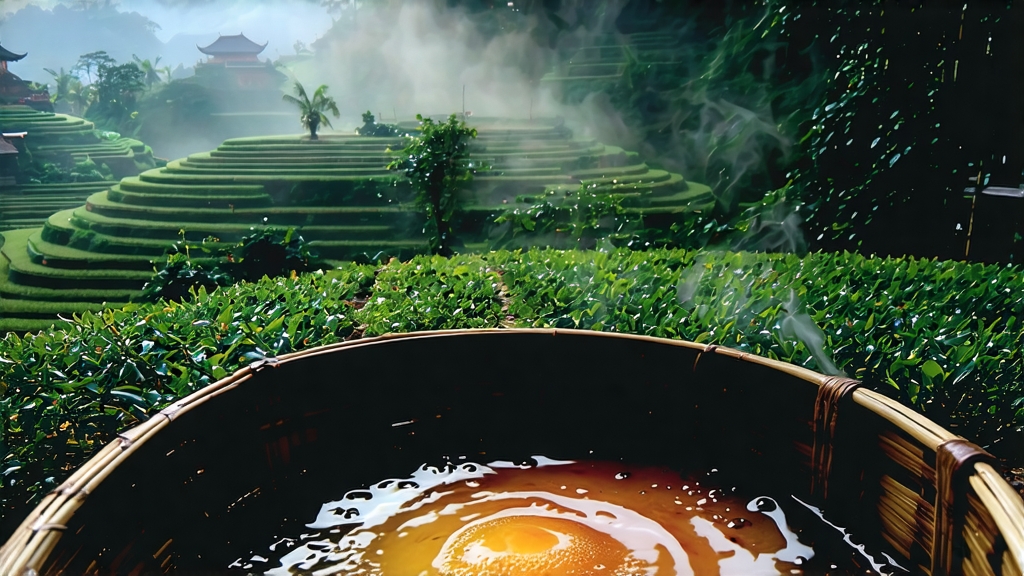
Tucked away in the southern folds of China’s Guangxi Zhuang Autonomous Region, where the warm, humid air rises from the Xi River basin and collides with the cool breath of the Dayao Mountains, a tea has been quietly fermenting for centuries. Liu Bao—literally “Six Forts”—is the least flamboyant yet most intriguing member of the dark-tea family. While Pu-erh commands global headlines, Liu Bao travels in the cargo holds of memory: once the ballast of junks sailing to Southeast Asia, today the darling of specialty tea bars from Berlin to Brooklyn. To understand Liu Bao is to listen to a story of humidity, wood, and time, told in the language of microbes.
Historical footprints
The earliest written record appears in the 1799 edition of the Cangwu County Gazetteer, noting that “dark tea from Liu Bao” was bartered for salt and medicine. By the late Qing, Liu Bao bricks were lashed together into long rafts and floated down the Xun River to Wuzhou, then transferred to ocean-going junks bound for Hong Kong, Malacca, and Jakarta. Dockworkers noticed that the tea arrived sweeter than when it left; the sweltering cargo holds had acted as giant incubators, accelerating a secondary fermentation that softened bitterness and birthed a mellow, medicinal liquor. In 1886 the British colonial government of Malaya even listed Liu Bao as a “required provision” for tin-mine laborers, believing it cured fever and dispelled “damp miasma.” Thus, long before the concept of “post-fermentation” entered tea lexicons, Liu Bao was already a globe-trotting probiotic.
Varietal identity
Liu Bao is made from a large-leaf landrace cultivar known locally as Zhong ye zhong (mid-leaf type), growing between 200 and 800 m on red lateritic soils. The same leaves could legally be used for green, oolong, or black tea, yet only when they undergo the double fermentation of piling and aging do they earn the name Liu Bao. The tea is therefore defined by process, not plant, placing it in the same dark-tea category as Pu-erh, Hunan Fu brick, Hubei Qing brick, Sichuan Kang brick, and Anxi Liu Bao’s lesser-known cousin, Liubao San. Within Liu Bao itself, three commercial grades exist—Special, First, and Second—based on leaf maturity and stalk ratio, but connoisseurs prefer to speak in vintage decades, warehouse styles, and basket sizes.
Crafting the darkness
Harvest begins after Qingming when two leaves and a bud have grown to the length of a thumb. The first steps look like green tea: withering on bamboo mats, wok-killgreen at 280 °C to arrest oxidation, and a short rolling to bruise cell walls. Then the path diverges. The damp leaves are piled 70 cm deep in a humid room lined with cedar planks. A unique “wet-pile” fermentation—guang xi wo dui—commences: workers spray controlled amounts of mountain spring water, cover the pile with jute sacks, and allow indigenous microbes (primarily Aspergillus niger, Blastobotrys adeninivorans, and a Guangxi-specific strain of Eurotium cristatum) to raise the temperature to 55 °C within 36 hours. Every two days the pile is turned, aerated, and re-moistened; the process lasts 25–30 days, twice as long as the typical shou Pu-erh pile, yielding a darker leaf and a sweeter base.
Post-pile, the tea is sun-dried for only a brief window; the final moisture goal is 12 %, higher than most dark teas, because Liu Bao will continue fermenting inside its package. Traditionally the tea is steamed soft, then packed by hand into cylindrical bamboo baskets—40 kg, 30 kg, or the diminutive 500 g “tong” used for dowry gifts. These baskets breathe, allowing micro-oxygenation while cedar slats impart a camphor note. Warehouses in Wuzhou are built on stilts above the river; night vapors drift through louvers, bathing the tea in a perpetual mist. A decade of this slow dance produces the coveted chen xiang (aged aroma): a marriage of wet earth, sandalwood, and dried longan.
Brewing rituals east and west
In Wuzhou te